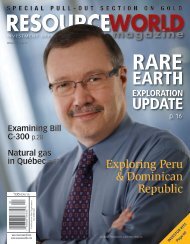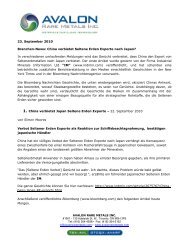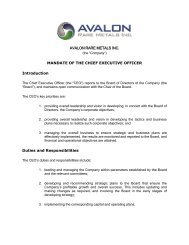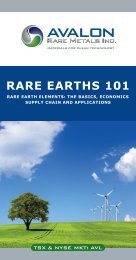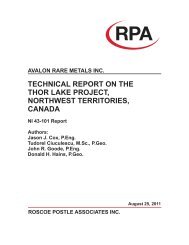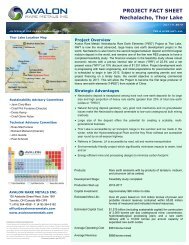technical report on the nechalacho deposit, thor lake project ...
technical report on the nechalacho deposit, thor lake project ...
technical report on the nechalacho deposit, thor lake project ...
You also want an ePaper? Increase the reach of your titles
YUMPU automatically turns print PDFs into web optimized ePapers that Google loves.
• loparite and eudialyte in alkaline intrusives (Kola Peninsula, Russia; Dubbo, Australia)<br />
• Pegmatites, hydro<strong>the</strong>rmal quartz and fluorite veins (Nor<strong>the</strong>rn Territories, Australia;<br />
Kar<strong>on</strong>ge, Burundi; Naboomspruit, South Africa)<br />
O<strong>the</strong>r generic types which may c<strong>on</strong>tain rare earths are:<br />
• Phosphates (Phosphoria Formati<strong>on</strong>, western USA),<br />
• Uranium <strong>deposit</strong>s in sandst<strong>on</strong>e and black shales (Wheeler River, Alberta; Willist<strong>on</strong><br />
Basin, Saskatchewan),<br />
• Myl<strong>on</strong>ites in limest<strong>on</strong>es (Nam-Nam-Xe, Vietnam),<br />
• Scheelite skarns (Ingichke, Uzbekistan),<br />
• Nickel <strong>deposit</strong>s (Sudbury Basin, Ontario).<br />
By far <strong>the</strong> most important of current sources are <strong>the</strong> Bayan Obo ir<strong>on</strong> rare earth <strong>deposit</strong>s near<br />
Baotou, Inner M<strong>on</strong>golia, <strong>the</strong> bastnaesite <strong>deposit</strong>s in Sichuan, China and <strong>the</strong> i<strong>on</strong>ic clay <strong>deposit</strong>s<br />
in sou<strong>the</strong>rn China. China is <strong>the</strong> dominant source of all rare earth oxides, accounting for<br />
approximately 97% of world producti<strong>on</strong> in 2009. Light rare earths are primarily produced in<br />
nor<strong>the</strong>rn China (Inner M<strong>on</strong>golia) and south-western China (Sichuan). The heavy rare earths are<br />
primarily produced in sou<strong>the</strong>rn China (Guangd<strong>on</strong>g), from i<strong>on</strong>ic clays.<br />
There are distinct differences in <strong>the</strong> elemental compositi<strong>on</strong> of various rare earth sources, as<br />
illustrated in Table 18-18.<br />
As a c<strong>on</strong>sequence of <strong>the</strong> mix of <strong>the</strong> individual elements within a raw material source, <strong>the</strong><br />
distributi<strong>on</strong> of supply of <strong>the</strong> individual elements does not match <strong>the</strong> distributi<strong>on</strong> of demand for<br />
<strong>the</strong> elements. The mixed compositi<strong>on</strong> of rare earth minerals necessitates <strong>the</strong> producti<strong>on</strong> of all<br />
of <strong>the</strong> elements within a given ore source. Such producti<strong>on</strong> does not necessarily equal <strong>the</strong><br />
demand for <strong>the</strong> individual oxides, leaving some in excess supply and o<strong>the</strong>rs in deficit. Overall<br />
producti<strong>on</strong> of rare earths <strong>on</strong> an oxide basis is <strong>the</strong>refore typically greater than <strong>the</strong> sum of<br />
demand for <strong>the</strong> individual elements in any given year.<br />
Total supply of rare earth oxides for 2008 was estimated at between 121,600 t<strong>on</strong>nes and<br />
127,100 t<strong>on</strong>nes, as illustrated in Table 18-19.<br />
Technical Report 43-101 – March 13, 2011 Page 18-74<br />
Prepared by Aval<strong>on</strong> Rare Metals Inc.





